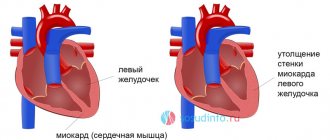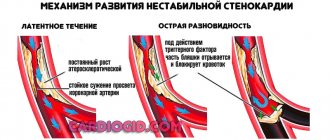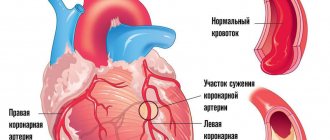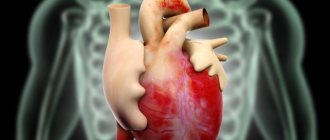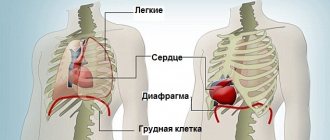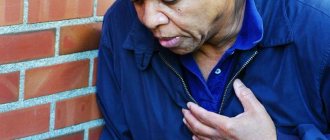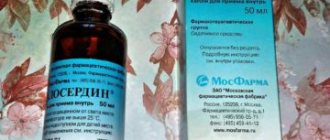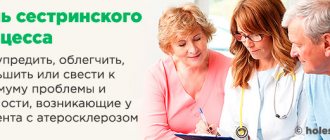Almost everyone has encountered this situation: a neighbor, relative or work colleague was taken away in an ambulance with a heart attack. The patient was subsequently diagnosed with a heart attack, severe arrhythmia, or aortic aneurysm. However, all these cases have a common pattern - the patient’s serious condition and a real threat to life.
It would be good if people were near such a patient and called an ambulance. During a heart attack, time is literally counted in minutes; death can occur suddenly. That is why everyone should know the first signs of a heart attack, what is necessary and what is strictly forbidden to do in this case.
Heart attack: what is it?
A heart attack is an acute condition characterized by particular severity and caused by the rapid development of heart failure. Severe spasm of the coronary vessels or their blockage by a thrombus leads to death (necrosis) of a section of the myocardium.
An attack of heart failure can occur both in heart patients (hypertension, diagnosed heart disease, etc.) and in completely healthy people. Often, an acute condition occurs in emotionally labile women with a history of vegetative-vascular dystonia. The peak of heart attacks occurs in spring, days of magnetic storms and hot weather.
Women of childbearing age are at the lowest risk. They are protected from a heart attack by hormones and an extensive network of small coronary vessels (a physiological feature of the female body). However, with the onset of menopause in women, they begin to occur equally often as in men. Moreover, the stronger sex has a greater chance of survival: women often die before emergency help arrives.
Main causes of heart attack:
- Developing myocardial infarction - necrosis of the heart muscle begins 30 minutes after the onset of the attack; such patients often have a history of cardiac ischemia and angina pectoris;
- Rhythm disturbances - severe tachycardia (cardiac rhythm), atrial fibrillation (rapid heartbeat followed by freezing);
- Aortic aneurysm - often combined with aortic defect and arrhythmia; its detachment provokes a sharp deterioration in the condition at night in bed;
- Pulmonary artery thromboembolism - often develops against the background of thrombophlebitis of the legs and in old age, death occurs in a matter of minutes;
- Progressive heart failure is the result of long-term cardiosclerosis, hypertension and other heart diseases; a sharp weakening of myocardial contractions can occur after the flu, an emotional reaction (both positive and negative), physical activity, and a change in atmospheric pressure.
Smoking is the first enemy of blood vessels. Women's addiction to cigarettes—a pack or more a day—causes frequent heart attacks at a young age.
Warning signs of a heart attack
Recent medical research, in particular from scientists at Harvard University, has identified symptoms that occur about a month before a heart attack. You should consult a cardiologist in cases where the following conditions are detected:
- Excessive fatigue is not ordinary fatigue after a day of work or household chores, but a complete lack of strength to perform simple actions (go to the store, climb the stairs). Fatigue does not go away even after a full sleep. Often women note that the usual load (for example, a bag or a light package of groceries) feels heavier. Many patients note more pronounced weakness, numbness or goosebumps on the fingers of the left hand.
- Mild pain in the chest can migrate (either stabbing under the chest on the left, or pressing behind the sternum). In the best case, a woman takes Corvalol, Corsiz or valerian drops. However, these drugs only have a calming effect, but do not improve blood supply to the myocardium.
- Shortness of breath occurs with little physical activity and sometimes at rest. When climbing stairs, a woman has to stop to catch her breath.
- In the mornings and throughout the day, dizziness occurs, to the point of staggering and the need to sit down. At the same time, the body becomes covered in cold sweat, the skin turns pale.
- Swelling - women, especially those who love high heels, note that the swelling in their legs has become stronger and does not disappear even after sleep. Often the hands become swollen (it is impossible to remove the ring from the finger), the face (swollen eyes in the morning).
- Flu-like condition - many people recall the fact that shortly before a heart attack they experienced a flu-like condition (fever, body aches, runny nose and cough).
The first symptoms of an impending heart attack indicate oxygen starvation of the myocardium and decreased contractility. Without medical intervention, acute ischemia eventually develops - a heart attack.
Important! A microinfarction may occur with similar symptoms. The resulting myocardial necrosis is often diagnosed later during an ECG. A microinfarction suffered “on your feet” is dangerous with a high risk of developing a large infarction in the future.
My heart skipped a beat
Suppose there is pain in the left side of the chest, or behind the sternum.
As people say, “it took my heart.” Or there were some interruptions in the functioning of the heart. How to understand what hurts? This could be pain in the heart itself, it could be intercostal neuralgia, a consequence of a displaced thoracic vertebra, or some neurogenic manifestations.
Since pain in the heart area is quite a serious symptom, there is no time to guess on your own. You must definitely call an ambulance. Do not panic, remain calm and call an ambulance. Or attract the attention of others so that they call 103.
First aid for heart pain
Only after calling an ambulance can you make a series of breath holds while exhaling. Exhale, do not breathe, inhale and after exhalation, hold again.
Bite the tip of your little finger. Strongly, to the point of pain, and for quite a long time, from 30 seconds to 2-3 minutes, squeeze the base of the nail phalanx of the little finger on both sides with your teeth.
Biting the little finger
A hard massage of the little finger for heart pain can be done to yourself or to another person who has been called for an ambulance. It must really hurt. Simple squeezing will not help here. Only through pain, but without fanaticism. No need to bite off your finger!
Symptoms of a heart attack: how to distinguish them from angina?
Most often, a heart attack occurs in the morning. Heart patients have become “accustomed” to their illness and do not pay due attention to some deterioration in their condition, continuing their usual lives - taking a shower, getting ready for work, etc. A heart attack occurs suddenly:
- Severe chest pain, pressing or sharp, is accompanied by palpitations (the heart jumps out of the chest) or freezing (a feeling of cardiac arrest). Pain can radiate to the neck, lower jaw, under the shoulder blade and arm on the left. Sometimes there is a feeling that the pain is localized in the stomach.
- The attack is accompanied by nausea and heartburn, less often vomiting.
- Shortness of breath - the patient gasps for air. With severe tachycardia, a sensation of a lump in the throat occurs. Later, wheezing is heard when breathing, and a wet cough sometimes with blood appears. This indicates progression of heart failure and pulmonary edema.
- The skin turns pale and becomes covered in cold sweat. With the development of heart failure, cyanosis (blueness of the skin) develops, and the extremities become cold.
- Dizziness often causes a person to fall to the ground. The patient's eyes and facial expressions express a genuine fear of disaster, but often he cannot even ask for help. It often takes 10 seconds from falling to losing consciousness, although this option is not necessary.
- Blood pressure increases during a heart attack, but sometimes remains within acceptable values.
Important! Patients with diabetes often develop a “silent”, asymptomatic heart attack.
A heart attack can mimic angina, exacerbation of a stomach ulcer and bronchial asthma. To recognize a heart attack, you should know:
- Neither anti-asthmatic sprays (Salbutamol) nor acid-reducing drugs (Renia, Almagel) will help.
- An attack of angina, unlike a true heart attack, lasts no more than 10 minutes. and is easily treated with Nitroglycerin.
- In case of a heart attack, Nitroglycerin does not help, and the attack lasts 30 minutes or more.
- Angina pain is always associated with physical or emotional stress. A heart attack often occurs while at rest.
- Rest and the patient taking a comfortable position do not bring relief. If, with a drop in pressure (hypotension, anemia, etc.) and a pre-fainting state, the patient is brought to consciousness with ammonia (bring it to the nose on a cotton swab), such a technique is useless in case of a heart attack.
First aid and medications for heart pain.
Pain in the cardiac region, heart pain is a frequent complaint of patients who seek medical help from a cardiologist. Pain in this area can be a manifestation not only of the heart, but also of other, no less serious diseases. Only cardiologists can accurately diagnose and prescribe treatment.
To confirm the diagnosis, anamnesis, blood tests, electrocardiogram, angiography, echocardiography, MRI, and ultrasound of the heart are necessary.
Consultations with psychotherapists, neurologists, pulmonologists, and gynecologists are necessary.
Heart attack: what to do to save life?
Many people who have experienced a heart attack complain about the callousness of the people around them: a person who has fallen on the street is often mistaken for a drunk and shunned. Meanwhile, time passes, and the chances of survival become less and less. First aid for a heart attack:
- Raise the patient's head (if he has fallen), unfasten the top buttons, and loosen the belt. Open the windows indoors.
- Call an ambulance immediately. If the patient is in a crowded place, shout to find a doctor or nurse. Their help will be needed to perform a massage in case of cardiac arrest.
- Urgently put Nitroglycerin under the patient's tongue. Before the ambulance arrives, if the pain does not go away, you can give up to 3 tablets. at intervals of 5 minutes. The fastest effect is provided by sprays with nitroglycerin - Nitrospray. Nitroglycerin lowers blood pressure! To avoid cardiogenic shock, its use should be limited if the upper a/d is below 100.
- In the best case, give the patient Aspirin in a dose of 300-500 mg (1/2 or a whole tablet). The patient must chew it! Using Aspirin in the first 30 minutes from the onset of an attack will avoid the formation of a blood clot and increase the chances of survival. You should notify your emergency physician about taking Aspirin.
- If you have a tonometer, your blood pressure should be measured before the ambulance arrives.
Important! If you are having a heart attack, you should use any means to attract attention and ask for help. If an attack occurs on the road, you need to stop the car on the side of the road, turn on the headlights or press the horn.
Specific techniques that should not be used during a heart attack:
- Deep cough
The deep cough technique for a heart attack—inhaling deeply and coughing until phlegm comes out—is widely circulated on the Internet. However, in the authoritative journal Journal of General Hospital Rochester, in which the article was allegedly first published, it was not and never was!
The effectiveness of this method has also not been confirmed by the US Heart Association. From a medical point of view, a deep cough can help with arrhythmia, but will only aggravate the condition during myocardial infarction, when any stress is not desirable. You shouldn't cough if you have a heart attack!
- Hot water bottle
The old remedy—a heating pad with hot water—will, at best, worsen the patient’s condition. Heat will provoke the spread of the necrotic focus and increase the area of the infarction.
- Antiarrhythmic drugs
Antiarrhythmics and adrenergic blockers (Rizoprol, Verapamil, etc.) should be taken if they were prescribed by a doctor previously (history of arrhythmia) or the patient has a rapid pulse. Self-administration of these drugs is not advisable.
